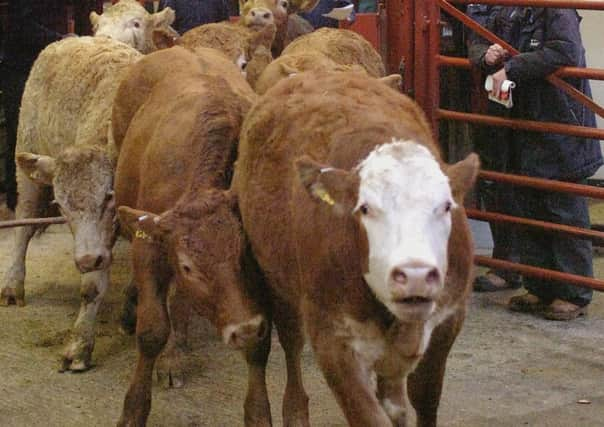Keep your weanlings protected against respiratory disease


Respiratory disease accounts for the greatest number of deaths in all age groups of cattle over three months of age according to the All Island Animal Disease Surveillance report 2016. Worryingly, the incidence of BRD has not changed very much in Northern Ireland over the past five years in spite of the cattle industry’s awareness of the impact of pneumonia on productivity.
Losses
Pneumonia in early life not only causes losses in terms of death, treatment costs and the inconvenience of treatment but it has been proven that recovered cattle fail to reach target weights thereafter.
Prior to weaning
Advertisement
Hide AdAdvertisement
Hide AdThe ideal strategy for prevention of respiratory disease can be implemented prior to weaning. Lungworm tend to be a significant threat to calves in the latter part of the summer months hence a suitable anthelmintic dosing programme should be adhered to throughout the grazing period with a dose given at least two weeks prior to weaning.
Creep feeding
Gradual separation of calves and their dams yields good results on farms where this is practised. This can be achieved through the use of a creep grazing or a creep feeding system. Creep grazing or feeding should be done for at least one month prior to weaning.
The weaning process
Removal of a proportion of the dams every five days from the batch is superior to abrupt weaning where all of the dams are removed at one time. This can minimise the negative effect of stress on the calves’ immune system. The remaining dams have a calming effect on the weaned calves. When the final group of cows are removed the majority of the calves are already weaned and settled.
Routine procedures
Procedures such as castration are ideally carried out four weeks before weaning or at least two weeks after weaning.
Purchasing weanlings
Advertisement
Hide AdAdvertisement
Hide AdMovement of weanlings to a new farm involves the stress of transport and mixing initially and also requires adjustment to a new diet and environment. Multi-sourcing calves can add an increased risk of disease. Calves which have been weaned according to the recommendations outlined above will be more settled at the sale. Aim to avoid calves that are vocalising excessively indicating that they may be just weaned prior to arrival at the sale.
Housing
Home bred calves should not be housed until approximately two weeks after weaning if possible. Purchased calves should be housed at an appropriate stocking density and have access to palatable feed and clean drinking water immediately after arrival. A comfortable dry lying area is essential.
Arrival procedure
A standardised routine can help to ensure that all calves receive the best care on arrival at the new farm. Options to consider including in this are weight checks (all calves will lose weight during lairage and transit), fluke and worm treatments, vaccination and occasionally antibiotics on advice from your veterinary surgeon.
Monitoring calves and case identification
After weaning or housing check calves at least twice daily for signs of disease. Cattle with respiratory disease may have an increased temperature and discharge from the nose and a cough with an increased speed and depth of breathing.
Cause of bovine respiratory disease (BRD)
Advertisement
Hide AdAdvertisement
Hide AdBRD is a multifactorial disease. Primary pathogens, usually viruses, can cause disease without the aid of any other pathogens. Secondary invaders, usually bacteria, contribute to existing disease and may result in death of the affected animal.
Bovine Respiratory Syncytial Virus (BRSV) and Parainfluenza-3 virus (PI3) are common primary pathogens which cause damage to the animal’s defences and allow bacteria including Mannheimia haemolytica to cause more severe disease. Bovine herpes virus-1 causes an upper respiratory tract disease in cattle known as IBR. Prevention of these viruses is a key factor in the control of pneumonia in calves and weanlings.
Pasteurella multocida and Mannheimia haemolytica are the most frequently diagnosed causes of fatal respiratory disease in Irish cattle. Mannheimia haemolytica, previously known as Pasteurella haemolytica, invades lung tissue when the animal is exposed to stressful conditions such as weaning, transport, mixing or housing. This bacterium triggers an inflammatory response in lung tissue which can rapidly damage lung tissue. Antibiotic treatment may be effective at killing Mannheimia haemolytica but the inflammation may continue.
Vaccination
The broadest protection against BRSV and PI-3 viruses and the bacteria Mannheimia haemolytica* can be provided by Bovipast RSP. Home bred weanlings should be vaccinated at least six weeks before weaning commences with a second dose given four weeks later. This allows the animal to develop a protective immune response before the stress of weaning has an impact on immune function. Bovilis IBR marker live can be administered either intranasally or intramuscularly as a single dose with either dose of Bovipast RSP. Purchased weanlings can receive Bovilis IBR marker live intranasally after arrival which will provide protection in four days. Bovipast RSP can be given at this time and a second dose four weeks later to provide broad protection against the common viruses and bacteria.
* Mannheimia haemolytica A1 and A6